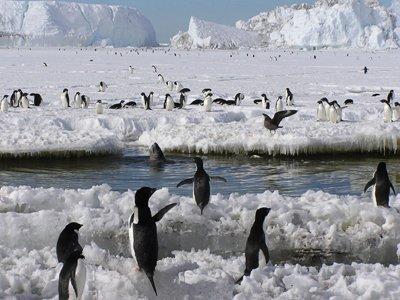Director: Werner Herzog
Starring: Werner Herzog (narrator)
UK Release date: 24 April 2009
Certificate: U (99 mins)
Werner Herzog has made a career out of documenting the extreme ends of the interaction between human beings and the natural world. Encounters at the End of the World builds on the themes of Grizzly Man (detailing the life and death of Timothy Treadwell and Amie Huguenard, grizzly bear activists who were killed by the bears they had lived among for thirteen years) – here it is the Antarctic collection of scientists and ‘professional dreamers’ that fall under his lens. As one of his interviewees puts it, the extreme conditions act as a natural filter of humanity: only those who are drawn to places like this end up there.
So it is that the cast appears: Dr Ainley, who has spent so long studying penguins that conversations with him are dead ends; the émigré from Eastern Europe whose backpack is always packed with tent, oar and canoe so that at any moment he can pick up and leave; the ‘philosopher and forklift truck driver’ discussing the universe’s self-receptive medium… Herzog’s skill is in posing basic questions in his drab, tri-tonal voice (it feels like a piano player who will only play three notes) and scooping up the answers with his camera.
Matching these rarities of human behaviour are the manifestations of nature at the poles. Nature films, despite their ubiquity, retain their power to stun. Encounters at the End of the World is an encyclopaedia of oddness: underwater cathedrals with pillared ice stabbing down from the roof; the seal voices coming up through the office floor that sound like spaceships shooting at each other; the myriad of tiny creatures that sting, stab and absorb each other in gruesome ways. When man and nature overlap, the strangeness multiplies: underneath the mathematical south pole lies a tiny shrine garlanded with popcorn in which lies a frozen sturgeon and some fake flowers. There is the sense of something deep calling to deep, in the relationship between the environment and those who come there.
Awe at the swathe of ignorance on which our everyday lives sit accompanies this film. We consider ourselves alive, knowledgeable to a decent extent about the world around us: perhaps we know the name of that tree, or which bird sounds like this. But beyond the beginnings of summer and the cap of blue sky there lie such marvels that wondering becomes the only logical response. Herzog’s film opens up a tiny patch of creation: the ‘great sea-monsters and all the creatures that glide and teem in the waters’ (Gen 1:21). Likewise the film reminds us – if we were in danger of forgetting – of the spectrum of human personality. What Larkin called ‘a unique endeavour… the million-petaled flower / Of being here’ comes across in those who seek out the hidden places of the earth, those who with us will fill the many rooms of our Father’s house.
Perhaps the best emblem of the film is this: a group of seven penguins are leaving the nesting area and heading across the ice for the sea. The camera captures them as they pause in the middle of the plain: to the right lies the sea, to the left, the nests. In the background are the mountains that are the rim of the central mass of Antarctica, a land without water 5,000km long. These seven black specks suddenly separate: four head onwards to the sea and two turn back, leaving one alone on the ice. The bird is still as the others move away right and left until, once they have left the screen, it turns away and begins its absurd, slow waddle towards the mountains. It is an inexplicable moment: that way lies death and solitude. Asked by Herzog whether it is possible to save the bird, Dr Ainley replies that if he returned it to the nest, it would only leave again in the same direction. The two men sit in silence until the penguin has vanished from sight.
Nathan Koblintz
![]() Visit this film's official web site
Visit this film's official web site






